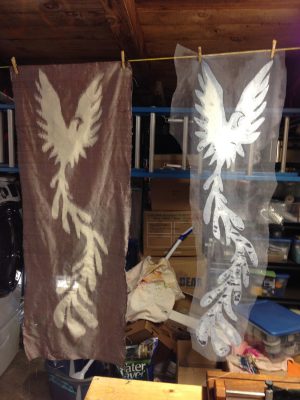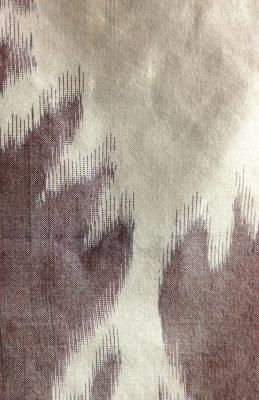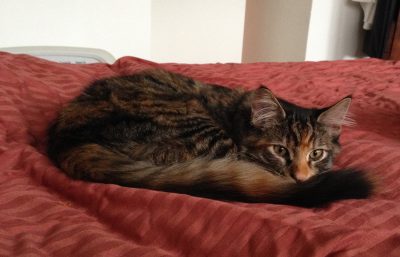By weaving like a maniac, I have finished the next sample. It came out quite well – here’s a photo of the undyed sample hanging next to the stencil:

It came out quite well – there is minimal distortion, except for the feathering every fourth thread which I mentioned in a previous post. And I like that feathering, as it blurs the edge and gives the impression of fire.
Here is a closeup of the piece, so you can see the feathering:

I then simmered it in soapy water (to take out the excess dye) and threw it into a low-water immersion dyebath. Here’s what it looks like now:

I don’t particularly like the result of overdyeing, for a couple of reasons. The top reason is because the black background simply isn’t dark enough to mask the overdyed pattern. I want subtle visual texture and a reddish tint in the background, not obvious pattern. As a result, the phoenix does not stand out as strongly as I would like.
The second reason is a color issue, which I had more or less expected but which I wasn’t sure how to solve. Yellow + black, when mixed, produce a greenish tint. As a result, the “flames” in the background look greenish, which I definitely don’t want.
The final reason is that I don’t like the scarlet in the tail. The contrast against the other colors is too high, producing a distracting pattern. I like the patterning in the yellow-orange portion at the top (which I deliberately kept lighter than the rest) a lot better.
Still, it’s pretty, and I learned a lot from making it. I feel like I’m (almost) ready to make the Real Thing. There are just one or two experiments I’d like to do first. I want to try weaving it in a 3-1 broken twill, so the warp dominates on the front side. That will let me get the background darker. I also want to try weaving in plain weave but with a very thin weft, 120/2 silk perhaps. And I’d love to try it with a wavy pattern, network drafted perhaps, to give the impression of heat waves.
None of those experiments can be done on the current warp, so I’m taking the remnants off. I’ve already started winding the next warp. This will be 30/2 silk sett for twill (36 ends per inch). Switching to a heavier thread means no more broken threads – important since repairing broken threads or knots in a stenciled warp is a real pain in the butt. And I’m planning to beam it on back to front, instead of my usual sectional warping, because I want to leave the raddle in place – it will help when I roll the stenciled warp back onto the warp beam. I’ve currently wound 1/8 of the warp, and am hoping to have it in place and ready to start dyeing/weaving by Thanksgiving. I’ll start with some smaller samples, then weave the bigger piece.
I have also made progress on figuring out the loom shipping. I spent a good chunk of time on Friday frantically researching options – thanks to everyone, especially Wee, for the advice! I’ve concluded that the cheapest way to ship the loom is to fly out, break it down, pack it into a wooden crate, and have a freight service haul it to California. It will cost about $1000 for the crate + shipping, plus another $1000 for plane flights, hotel, rental car, packing materials, etc. Even adding $2000 to the price of the loom, it’s still a steal.
About the loom: it’s a 48″, 40-shaft AVL Ultimate Dobby Loom, with E-lift. The UDLs were an early attempt at 40 shafts, and the E-lift is also one of the earliest electronic lifting mechanisms, but it is currently in working order. I did check with AVL, and it is upgradable and/or repairable if necessary. I can’t resist the prospect of weaving on 40 shafts – even if it means upgrading to a much larger loom. (My house is not big, so fitting a huge loom is a real stretch. I will probably have to do some destashing and serious rearrangement to fit it into the garage.)
Finally, Fritz and Tigress have now been with us for two months and two days, and have literally doubled their weight in that time. (Tigress now weighs 5.75 lbs, Fritz 4.75.) According to my calculations, that means that a year from now we’ll have a pair of 300-pound cats – mighty hunters indeed! (That, of course, is why you should never calculate a curve from two data points. 😉 ) More seriously, in another few months, they’ll likely be full grown (hopefully not 300 pounds, though!). All the more reason to cherish their adorable kittenhood.
And here are the adorable teenage tykes:


Fritz still looks a bit kittenish (especially with those enormous ears!), but Tigress now looks like a normally proportioned cat, except she’s a lot smaller.

I learn so much from your blog. I did a workshop with a wonderful lady, Elda Kohls and we did the stenciling on the loom with a padded piece of plastic cut to fit between the beater and the front beam. I did not have my warm close enough to suit me. We actually laid the stencil (s) on the warp and then painted or daubbed the fabric paint on the warp. Let it dry. Then wove with the warp color (I had white on). Think I will try a finer weft next time.So what you are doing really interests me, Thanks much